Basel
![]()
The title of this article is ambiguous. For other meanings, see Basel (disambiguation).
Basel![]() (French Bâle, Italian Basilea, Rhaeto-Romanic
(French Bâle, Italian Basilea, Rhaeto-Romanic![]() ) is a major Swiss city and the capital of the canton of Basel-Stadt, which it forms with the municipalities of Riehen and Bettingen. After Zurich and Geneva, Basel is the third largest city in Switzerland with 173,232 inhabitants.
) is a major Swiss city and the capital of the canton of Basel-Stadt, which it forms with the municipalities of Riehen and Bettingen. After Zurich and Geneva, Basel is the third largest city in Switzerland with 173,232 inhabitants.
Basel is considered the cultural capital of Switzerland. With nearly forty museums throughout the canton and a wide range of cultural offerings, Basel is famous for its numerous world-class art and cultural institutions, which also makes the city one of the largest cultural centers in Europe in relation to its size and population. The municipal art museum here exhibits what is generally considered to be the most important public art collection in Switzerland. Together with the "Amerbach Cabinet" acquired by the city in 1661, the collection is considered the oldest art museum in the world open to the public.
Founded in 1460, the University of Basel is the oldest in Switzerland and one of the oldest in Europe. Over the centuries, Erasmus of Rotterdam, Paracelsus, Daniel Bernoulli, Leonhard Euler, Friedrich Nietzsche, Karl Jaspers, the Nobel Prize winner Tadeus Reichstein and the philosopher Jeanne Hersch have all taught and conducted research here. In addition, the first World Zionist Congress took place in Basel in 1897 under the leadership of Theodor Herzl. Until the founding of the State of Israel in 1948, the congress was held ten times in the city on the bend of the Rhine, more than in any other city in the world.
Basel is a world-leading centre for the chemical and pharmaceutical industries, a world-renowned trade fair centre and an important location as a banking centre. Among others, the two pharmaceutical companies Novartis and Hoffmann-La Roche as well as the Bank for International Settlements have their global headquarters in Basel.
According to a ranking by the management consulting firm Mercer, Basel today (as of 2019) ranks alongside Zurich and Geneva as part of the ten cities with the highest quality of life in the world.
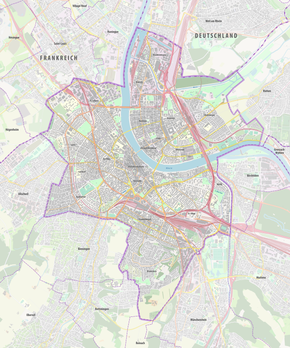
City of Basel
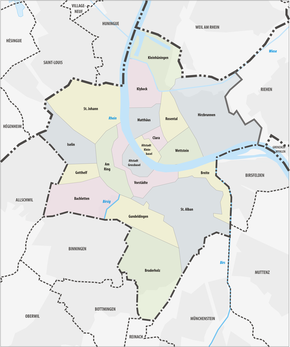
Quarters
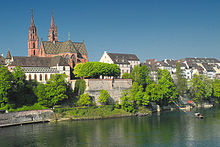
Basel Cathedral, together with its Palatinate, forms the historic centre of the city on the bend of the Rhine
Geography
Location
Located in the extreme northwest of Switzerland, the city lies on both sides of the Rhine. Along with parts of the cantons of Schaffhausen and Zurich, Kleinbasel and the northern part of the canton of Basel-Stadt are among the only areas in Switzerland on the right bank of the High Rhine.
The Rhine changes its direction from east-west to south-north in the urban area of Basel - at the Rhine bend between the Swiss Jura and the foothills of the Black Forest. Here ends the Rhine section High Rhine and begins the Upper Rhine. Shortly before this point, on the higher southern bank of the Rhine, the Birs flows into the Hochrhein, which forms the border with the canton of Basel-Landschaft; the St. Alban-Teich canal, which is diverted from the Birs and comes from the south, also carries water into the Rhine. Immediately below the Mittlere Brücke is the mouth of the Birsig, which is thus the first tributary of the Upper Rhine. On the flatter northern bank, large industrial areas extend from which the Wiese flows into the Upper Rhine.
The Rhine, which shapes the city, is considered an international waterway from its mouth to Basel's old town (historic Mittlere Rheinbrücke). Switzerland was granted these traffic rights in 1868 by the Mannheim Act.
Thanks to its location, Basel became a junction of important transport routes early on and thus an important trading centre. The city is therefore one of the most densely populated areas in Europe, but with a large common land area has 320 ha of green space and 71 ha of forest.
The city of Basel and the two municipalities of Riehen and Bettingen, including their water areas, cover 3694 ha, making it the smallest Swiss canton in terms of area. Nevertheless, there are considerable differences in altitude within this relatively small piece of land. The lowest point in the canton of Basel-Stadt is measured at the Rhine harbour in Kleinhüningen at 245 m, Münsterplatz in the centre is 270 m above sea level, and the highest elevation is above Bettingen at St. Chrischona at 522 m - this is also where the St. Chrischona television tower, the highest free-standing structure in Switzerland, is located.
Neighboring communities
The city of Basel is located at the southern end of the Upper Rhine Plain and the western beginning of the High Rhine Plain at the border triangle of Switzerland-Germany-France, and for this reason has suburbs in all three countries. The inhabitants of Basel are called Basler (or Stadtbasler to differentiate them from the inhabitants of the canton of Basel-Landschaft).
The neighbouring municipalities bordering Basel are (clockwise):
- to the north and north-east Weil am Rhein (Germany) and Riehen (Canton of Basel-Stadt)
- from east to south Birsfelden, Muttenz, Münchenstein, Reinach and Bottmingen (all in the canton of Basel-Landschaft),
- in the west, Binningen and Allschwil (both in the canton of Basel-Landschaft) and the Alsatian municipalities of Saint-Louis and Huningue (France).
· 
View from the St. Martin's Tower of the Basle Cathedral to Kleinbasel and the Rhine bend. On the left edge the Mittlere Brücke can be seen, on the right the Messeturm, Roche Tower and the Wettsteinbrücke.
Climate
The city of Basel has an extremely mild, sunny climate thanks to its location in the Rhine Valley due to the Mediterranean air flowing in from the Burgundian Gate and also due to its sheltered location as in a little valley and, thanks to the Möhlin jet, there is little fog in autumn compared to the Central Plateau. The annual mean temperature is 10.5 °C, with the coldest monthly mean temperatures measured in January at 1.6 °C and the warmest in July at 19.7 °C. The region has an average of around 64 frost days. On average, around 64 frost days and 13 ice days are to be expected here. There are around 52 summer days on average over the year, while 10.8 heat days are normally recorded. The MeteoSwiss weather station is located at an altitude of 316 m above sea level in the suburb of Binningen, about 2 km from the city centre (as the crow flies).
At 12.26 °C, the annual mean temperature in 2018 was 2.52 K above the 1961-1990 period mean of 9.74 °C. There is comparatively little rainfall with around 842 mm per year (period 1981-2010). Various exotic plant and palm species also thrive excellently for this reason. Summers can be very hot, while winters are usually mild, even compared to the rest of German-speaking Switzerland.
| Basel/Binningen 1981-2010 | ||||||||||||||||||||||||||||||||||||||||||||||||
| Climate diagram | ||||||||||||||||||||||||||||||||||||||||||||||||
| ||||||||||||||||||||||||||||||||||||||||||||||||
| Monthly average temperatures and precipitation for Basel/Binningen 1981-2010
Source: | |||||||||||||||||||||||||||||||||||||||||||||||||||||||||||||||||||||||||||||||||||||||||||||||||||||||||||||||||||||||||||||||||||||||||||||||||||||||||||||||||||||||||||||||||||||||||||||||||||||||||||||||||||||||||||||||||||||||||||||||||||||||||||||||||||||||||||
Geology
Basel lies in a depression created by the Rhine and surrounded by three low to medium mountain ranges, the French Vosges to the west, the German Black Forest to the east, and foothills of the Jura to the south, southwest and east. As mentioned above, this depression has an impact on the climate of the city and region. The Upper Rhine Plain thus begins in Basel.
Potential earthquake area
→ Main article: Basel earthquake zone
The three plates of the Black Forest, the Vosges and the Jura Mountains collide in the Basel depression and their continuous movement causes a potential earthquake hazard. Basel is one of the most exposed earthquake areas in Switzerland. One of the largest earthquakes in Switzerland occurred in Basel in 1356 and claimed several hundred lives.
Geothermal
→ Main article: Deep heat mining Basel
In the early years of the 21st century, the idea was born to use geothermal energy to harness the energy of an injected underground water reservoir at a depth of 5000 meters below the city. However, the operators underestimated the risk of earthquakes. After test drillings in 2007 and 2008, the Deep Heat Mining Basel project had to be stopped due to individual earth tremors and the rock had to be examined more closely. In January 2012, criminal proceedings were brought against the operators of the project, resulting in an acquittal.
Quarters
The city is divided into Grossbasel on the left (south-western) side of the Rhine and Kleinbasel on the right bank of the Rhine. The centre of Basel is the old town in the Grossbasel area around the Marktplatz - where the town hall also stands (construction began in 1504) - and the Münsterhügel with the Pfalz-Terrasse rising above the Rhine. The Mittlere Brücke (Middle Bridge) connects the old town on both sides of the Rhine. The tram runs through the city centre, which has been freed from motor traffic.
The city of Basel does not have any political districts or city quarters, but is divided for statistical purposes according to residential areas, the so-called quarters. There are 19 of these quarters, distributed on the left and right of the Rhine.
- Neighbourhoods on the left bank of the Rhine → Grossbasel: Altstadt Grossbasel, suburbs, Am Ring, Breite, St. Alban/Gellert, Gundeldingen, Bruderholz, Bachletten, Gotthelf, Iselin and St. Johann
- Quarters on the right bank of the Rhine → Kleinbasel: Altstadt Kleinbasel, Clara, Wettstein, Hirzbrunnen, Rosental, Matthäus and Klybeck as well as Kleinhüningen (incorporated in 1893)
| Quartier | Hectare | Quartier | Hectare | |
| Old Town Grossbasel | 37,63 | Old Town Kleinbasel | 24,21 | |
| Suburbs | 89,66 | Clara | 23,66 | |
| On the ring | 90,98 | Wettstein | 75,44 | |
| Wide | 68,39 | Hirzbrunnen | 305,32 | |
| St. Alban | 294,46 | Rose Valley | 64,33 | |
| Gundeldingen | 123,19 | Matthew | 59,14 | |
| Bruderholz | 259,61 | Klybeck | 91,19 | |
| Bachletten | 151,39 | Kleinhüningen | 136,11 | |
| Gotthelf | 46,62 | city of Basel | 2275,05 | |
| Iselin | 109,82 | Riehen | 1086,10 | |
| St. John | 223,90 | Bettingen | 222,69 | |
| Canton Basel-City | 3583,84 | |||
Each of the quarters is additionally subdivided into residential districts. Some residential district names are synonymous with the quarter in colloquial language, e.g. residential district Kannenfeld (St. Johann quarter), Lehenmatte (Breite quarter) or Gellert, Dreispitz and St. Jakob (St. Alban quarter). An unofficial, city-wide known name for parts of the Bachletten and Gotthelf quarters is the Neubad.
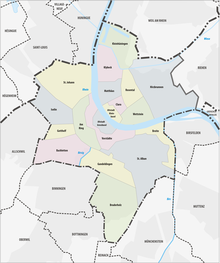
Basel quarters

Basel, Münsterhügel and Rheinpfalz
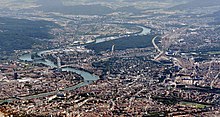
Basel and Rhine bend from the northwest bird's eye view

The cathedral hill of Basel seen from the right bank of the Rhine
Name
The origin of the name Basel is not clear. It is assumed that the name is of Roman origin. The former Celtic name of the place is unknown.
The name probably derives from the well-documented Roman personal name Basilius. Place names derived from a suffixless personal name are relatively common in western Switzerland. They are mostly elliptical phrases, where the original Latin common noun has been omitted. Basel is thus likely to be an elliptical formation from an original place name of the type villa Basilis. Who this eponymous Basil was is unknown.
There were also other explanations, for example the derivation from the Greek Basileus, king, (from which the Latin personal name is also derived) or from Basilika; in 1786 Peter Ochs even proposed twelve different interpretations of the name. All these alternative explanations are rejected today.
The oldest known source mentioning the name Basilia comes from the Roman historian Ammianus Marcellinus, who reports that Emperor Valentinian encamped with his troops at Basilia in 374.
A manuscript of the diocese of Basel, the age of which is unknown and which is only dated "before 1461", mentions the name Basel in an account of events that took place in 237/238 ("Basileam applicuerunt"). From this, however, it cannot necessarily be concluded that the name was already in use around 237.
The Celtic names of both the settlement of Basel-Gasfabrik (see below, para. Latène period) and the settlement on the Münsterhügel are unknown. Although Marcellinus mentions a Celtic place name Robur in his report on Valentinian, he evidently refers this name to the fort built by Valentinian on the right bank of the Rhine and not to the settlement.
From the Latin Basilia, the Italian variant Basilea developed later, which is used today in almost all Romance languages; the only exception was the Old French variant Basle, which is still widespread in English-speaking countries and from which the current French spelling Bâle developed. The Germanic variant became established early on and, with few exceptions, is also in use in the other (Eastern) European and non-European languages; only the West Slavic languages and the Greek language use a variation of the Romance name. A special feature is the Icelandic exonym Buslaraborg; it originates from the Leiðarvísir of the monk Níkulás Bergsson, published around 1194, and is still common in Icelandic usage today.
Search within the encyclopedia